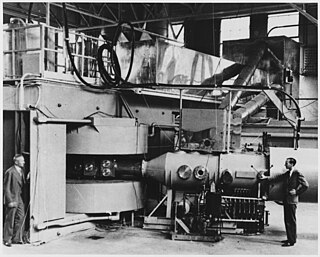
A cyclotron is a type of particle accelerator invented by Ernest O. Lawrence in 1929-1930 at the University of California, Berkeley, and patented in 1932. A cyclotron accelerates charged particles outwards from the center along a spiral path. The particles are held to a spiral trajectory by a static magnetic field and accelerated by a rapidly varying electric field. Lawrence was awarded the 1939 Nobel prize in physics for this invention.

A Van de Graaff generator is an electrostatic generator which uses a moving belt to accumulate electric charge on a hollow metal globe on the top of an insulated column, creating very high electric potentials. It produces very high voltage direct current (DC) electricity at low current levels. It was invented by American physicist Robert J. Van de Graaff in 1929.
The potential difference achieved by modern Van de Graaff generators can be as much as 5 megavolts. A tabletop version can produce on the order of 100,000 volts and can store enough energy to produce a visible spark. Small Van de Graaff machines are produced for entertainment, and for physics education to teach electrostatics; larger ones are displayed in some science museums.

Robert Jemison Van de Graaff was an American engineer, physicist, and noted for his design and construction of high-voltage Van de Graaff generators. He taught at Princeton University and Massachusetts Institute of Technology.

A linear particle accelerator is a type of particle accelerator that accelerates charged subatomic particles or ions to a high speed by subjecting them to a series of oscillating electric potentials along a linear beamline. The principles for such machines were proposed by Gustav Ising in 1924, while the first machine that worked was constructed by Rolf Widerøe in 1928 at the RWTH Aachen University.
Linacs have many applications: they generate X-rays and high energy electrons for medicinal purposes in radiation therapy, serve as particle injectors for higher-energy accelerators, and are used directly to achieve the highest kinetic energy for light particles for particle physics.
Accelerator physics is a branch of applied physics, concerned with designing, building and operating particle accelerators. As such, it can be described as the study of motion, manipulation and observation of relativistic charged particle beams and their interaction with accelerator structures by electromagnetic fields.

The National Electrical Code (NEC), or NFPA 70, is a regionally adoptable standard for the safe installation of electrical wiring and equipment in the United States. It is part of the National Fire Codes series published by the National Fire Protection Association (NFPA), a private trade association. Despite the use of the term "national", it is not a federal law. It is typically adopted by states and municipalities in an effort to standardize their enforcement of safe electrical practices. In some cases, the NEC is amended, altered and may even be rejected in lieu of regional regulations as voted on by local governing bodies.

The New England Conservatory of Music (NEC) in Boston, Massachusetts, is the oldest independent school of music in the United States, and it is widely recognized as one of the country's most distinguished music schools. NEC is especially known for its strings, piano, woodwinds, and brass departments, and its prestigious chamber music program.

Neutron generators are neutron source devices which contain compact linear particle accelerators and that produce neutrons by fusing isotopes of hydrogen together. The fusion reactions take place in these devices by accelerating either deuterium, tritium, or a mixture of these two isotopes into a metal hydride target which also contains deuterium, tritium or a mixture of these isotopes. Fusion of deuterium atoms results in the formation of a He-3 ion and a neutron with a kinetic energy of approximately 2.5 MeV. Fusion of a deuterium and a tritium atom results in the formation of a He-4 ion and a neutron with a kinetic energy of approximately 14.1 MeV. Neutron generators have applications in medicine, security, and materials analysis.

An arc-fault circuit interrupter (AFCI) also known as an arc-fault detection device (AFDD) is a circuit breaker that breaks the circuit when it detects an electric arc in the circuit it protects to prevent electrical fires. An AFCI selectively distinguishes between a harmless arc, and a potentially dangerous arc.

The Paul Scherrer Institute (PSI) is a multi-disciplinary research institute which belongs to the Swiss Federal Institutes of Technology Domain covering also ETH Zurich and EPFL. It was established in 1988 through the merger of EIR and SIN. It is based in Villigen and Würenlingen.

Electrical wiring is an electrical installation of cabling and associated devices such as switches, distribution boards, sockets, and light fittings in a structure.

A pelletron is a type of electrostatic particle accelerator similar to a Van de Graaff generator. Pelletrons have been built in many sizes, from small units producing voltages up to 500 kilovolts (kV) and beam energies up to 1 megaelectronvolt (MeV) of kinetic energy, to the largest system, which has reached a DC voltage of over 25 megavolts and produced ion beams with energies over 900 MeV.

Unguja North Region is one of the 31 regions of Tanzania. Located on the island of Zanzibar, Mkokotoni serves as the region's capital. Zanzibar North is divided into two districts, Kaskazini A and Kaskazini B.
Voltage drop is the decrease of electrical potential along the path of a current flowing in an electrical circuit. Voltage drops in the internal resistance of the source, across conductors, across contacts, and across connectors are undesirable because some of the energy supplied is dissipated. The voltage drop across the electrical load is proportional to the power available to be converted in that load to some other useful form of energy.
The Research School of Physics and Engineering (RSPE) was established with the creation of the Australian National University (ANU) in 1947. Located at the ANU's main campus in Canberra, the school is one of the four founding research schools in the ANU's Institute of Advanced Studies.
The Dual-Axis Radiographic Hydrodynamic Test Facility (DARHT) is a facility at Los Alamos National Laboratory which is part of the Department of Energy's stockpile stewardship program. It uses two large X-ray machines to record three-dimensional interior images of materials. In most experiments, materials undergo hydrodynamic shock to simulate the implosion process in nuclear bombs and/or the effects of severe hydrodynamic stress. The tests are described as "full-scale mockups of the events that trigger the nuclear detonation". The powerful pulsed X-ray beams allow for an ultra-fast motion picture to be constructed showing the details of the process being studied in three dimensions. The tests are often compared with computer simulations to help improve the accuracy of the computer code. Such testing falls under the category of sub-critical testing.
In electrical engineering low voltage is a relative term, the definition varying by context. Different definitions are used in electric power transmission and distribution, and electrical safety codes define "low voltage" circuits that are exempt from the protection required at higher voltages. These definitions vary by country and specific codes or regulations.

An electrostatic nuclear accelerator is one of the two main types of particle accelerators, where charged particles can be accelerated by subjection to a static high voltage potential. The static high voltage method is contrasted with the dynamic fields used in oscillating field particle accelerators. Owing to their simpler design, historically these accelerators were developed earlier. These machines are operated at lower energy than some larger oscillating field accelerators, and to the extent that the energy regime scales with the cost of these machines, in broad terms these machines are less expensive than higher energy machines, and as such they are much more common. Many universities worldwide have electrostatic accelerators for research purposes.
Arizona Accelerator Mass Spectrometry Laboratory focuses on the study of cosmogenic isotopes, and in particular the study of radiocarbon, or Carbon-14. As a laboratory, part of its aim is to function as a research center, training center, and general community resource. Its stated mission is conducting original research in cosmogenic isotopes. The AMS laboratory was established in 1981 at the University of Arizona.

















